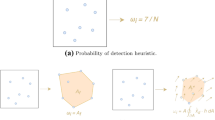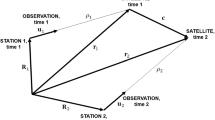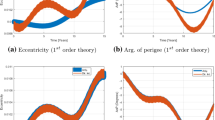Abstract
In the Initial Orbit Determination (IOD) context, Admissible Regions are subsets of parameter space of orbital elements that are reckoned as functions of the tracking measurement variables. Physically acceptable orbits, e.g., orbits with negative energies, constitute an Admissible Region. This paper defines sets of orbits that satisfy constraints imposed by the measurement variables. Using a probabilistic representation of constraints on some of the orbital parameters the Admissible Region can be further constrained to give a Probabilistic Admissible Region (PAR). PAR gives a particle cloud representation of the initial probability density function (pdf) of the state of a Resident Space Object (RSO). This paper presents a geometric solution to the Probabilistic Admissible Region (G-PAR). G-PAR is a set of algorithms sharing the same underlying template that geometrically maps postulated statistics on some orbital elements and statistics of the measurement process to the uncertainty in the states. The proposed scheme gives a simple closed-form solution for mapping particles to get the PAR pdf for the first time. This speeds up the PAR initial orbit determination with a single partial state measurement. The effectiveness of the proposed G-PAR is shown on diverse combinations of sensors and prior knowledge.



















Similar content being viewed by others
References
Gooding, R.H.: A new procedure for the solution of the classical problem of minimal orbit determination from three lines of sight. Celest. Mech. Dyn. Astron. 66(4), 387–423 (1997)
Faber, W., Chakravorty, S., Hussein, I.: Multi-object tracking with multiple birth, death, and spawn scenarios using a randomized hypothesis generation technique (RFISST). In: Proceedings of the 19th International Conference on Information Fusion, pp. 154–161. IEEE, Darmstadt, Germany (2016)
Gaebler, J.A., Axelrad, P., Schumacher, P.W.: CubeSat cluster deployment track initiation via a radar admissible region birth model. J. Guid. Control. Dyn. 43(10), 1927–1934 (2020). https://doi.org/10.2514/1.G005139
Mishra, U.R.: Multiple hypothesis tracking filter with lambert post filtering for multiple space object tracking
DeMars, K., Jah, M.: Probabilistic initial orbit determination using radar returns. Adv. Astronaut. Sci. 150, 35–54 (2014)
DeMars, K.J., Jah, M.K.: Initial orbit determination via gaussian mixture approximation of the admissible region. Adv. Astronaut. Sci. 143 (2012). (Proceedings of the 22nd AAS/AIAA Space Flight Mechanics Meeting, Charleston, SC, January 29–February 2 2012, Paper AAS 12-260)
Hussein, I.I., Roscoe, C.W.T., Mercurio, M., Wilkins, M.P., Schumacher, P.W.: Probabilistic admissible region for multihypothesis filter initialization. J. Guid. Control. Dyn. 41(3), 710–724 (2018). https://doi.org/10.2514/1.G002788
Milani, A., Gronchi, G.F., de Michieli Vitturi, M., Knežević, Z.: Orbit determination with very short arcs: I. Admissible regions. Celest. Mech. Dyn. Astron. 90(1–2), 59–87 (2004)
Milani, A., Knežević, Z.: From astrometry to celestial mechanics: orbit determination with very short ARCS. Celest. Mech. Dyn. Astron. 92(1–3), 1–18 (2005)
Tommei, G., Milani, A., Rossi, A.: Orbit determination of space debris: admissible regions. Celest. Mech. Dyn. Astron. 97, 289–304 (2007)
Kelecy, T., Shoemaker, M., Jah, M.: Application of the constrained admissible region multiple hypothesis filter to initial orbit determination of a break-up. In: Proceedings of the 6th European Conference on Space Debris Darmstadt, Germnay (08/2013)
Roscoe, C.W.T., Hussein, I.I., Wilkins, M.P., Schumacher, P.W. Jr.: The probabilistic admissible region with additional constraints. Adv. Astronaut. Sci. 156, 117–130 (2015). (Proceedings of the AAS/AIAA Astrodynamics Specialist Conference, Vail, CO, August 9–13 2015, Paper AAS 15-577)
Roscoe, C.W.T., Schumacher, P.W. Jr., Wilkins, M.P.: Parallel track initiation for optical space surveillance using range and range-rate bounds. Adv. Astronaut. Sci. 150, 989–1008 (2014). (Proceedings of the AAS/AIAA Astrodynamics Specialist Conference, Hilton Head, SC, August 11–15 2013, Paper AAS 13-767)
Roscoe, C.W.T., Wilkins, M.P., Hussein, I.I., Schumacher, P.W. Jr.: Uncertain angles-only track initiation for SSA using different IOD methods. Adv. Astronaut. Sci. 158 (2016). (Proceedings of the 26th AAS/AIAA Space Flight Mechanics Meeting, Napa, CA, February 14–18 2016, Paper AAS 16-207)
Worthy III, J.L., Holzinger, M.J.: Incorporating uncertainty in admissible regions for uncorrelated detections. In: Proceedings of the AIAA/AAS Astrodynamics Specialist Conference, San Diego, CA (2014)
DeMars, K.J., Jah, M.K.: Probabilistic initial orbit determination using gaussian mixture models. J. Guid. Control. Dyn. 36(5), 1324–1335 (2013)
DeMars, K.J., Jah, M.K.: Evaluation of the information content of observations with application to sensor management for orbit determination. Adv. Astronaut. Sci. 142 (2011). (Proceedings of the AAS/AIAA Astrodynamics Specialist Conference, Girdwood, AK, July 31–August 4 2011, Paper AAS 11-606)
Hussein, I.I., Roscoe, C.W.T., Wilkins, M.P., Schumacher, P.W. Jr.: Probabilistic admissibility in angles-only initial orbit determination. In: Proceedings of the 24th International Symposium on Space Flight Dynamics, Laurel, MD (2014)
Cai, H., Hussein, I., Jah, M.: Possibilistic admissible region using outer probability measure theory. Acta Astronaut. 177, 246–257 (2020). https://doi.org/10.1016/j.actaastro.2020.07.041
Hussein, I.I., Roscoe, C.W.T., Schumacher, P.W. Jr., Wilkins, M.P.: Probabilistic admissible region for short-arc angles-only observation. In: Proceedings of the Advanced Maui Optical and Space Surveillance Technologies Conference, Wailea, HI (2014)
Mishra, U.R., Faber, W.R., Chakravorty, S., Hussein, I., Hesar, S., Sunderland, B.: Geometric solution to probabilistic admissible region (G-PAR). In: Proceedings of the Advanced Maui Optical and Space Surveillance Technologies Conference, Wailea, HI, September 27–30 (2022)
Raihan, D., Chakravorty, S.: Particle gaussian mixture filters. Technical Report arXiv:1603.04510. (2016)
Raihan, D., Chakravorty, S.: Particle gaussian mixture (PGM) Filters. In: Proceedings of the 19th International Conference on Information Fusion, pp. 1369–1376. IEEE, Piscataway, NJ (2016)
Bate, R.R., Mueller, D.D., White, J.E.: Fundamentals of astrodynamics. Dover, New York (1971)
Vallado, D.A., McClain, W.D.: Fundamentals of astrodynamics and applications. Microcosm Press, Hawthorne (2013)
Schumacher, P.W., Gaebler, J.A., Roscoe, C.W.T., Wilkins, M.P., Axelrad, P.: Parallel initial orbit determination using angles-only observation pairs. Celest. Mech. Dyn. Astron. 130, 60 (2018). https://doi.org/10.1007/s10569-018-9852-6
Mishra, U.R., Faber, W.R., Chakravorty, S., Hussein, I., Hesar, S., Sunderland, B.: Geometric solution to probabilistic admissible region (G-PAR) with SDA radar observations (2022). (2022 AAS/AIAA Astrodynamics Specialist Conference, Charlotte, NC, AAS-22-855)
Mishra, U.R.: On selected topics in space domain awareness. In: PhD thesis, Texas A &M University (2022)
Jones, B.A.: CPHD filter birth modeling using the probabilistic admissible region. IEEE Trans. Aerosp. Electron. Syst. 54(3), 1456–1469 (2018). https://doi.org/10.1109/TAES.2018.2793378
Faber, W.R., Mishra, U.R., Chakravorty, S., Hussein, I.: Application of a randomized-finite set statistics technique (R-FISST) to space situational awareness. J. Astronaut. Sci. 69(4), 1149–1178 (2022)
Mishra, U.R., Faber, W.R., Chakravorty, S., Hussein, I.: Applications of a MCMC sampling and clustering methods based randomized-finite set statistics technique (R-FISST ii) (2021). (31st AAS/AIAA Space Flight Mechanics Meeting)
Chakravorty, S., Faber, W.R., Hussein, I.I., Mishra, U.R.: A belief space perspective of RFS based multi-target tracking and its relationship to MHT. ArXiv e-prints (2020)
Acknowledgements
The authors are thankful to Dr. Erik Blasch, AFOSR, and AFWERX for providing generous funding to support this research work via contract no. FA9550-21-P-0008.
Author information
Authors and Affiliations
Corresponding author
Ethics declarations
Conflict of interest
The authors have no conflict of interest to declare.
Additional information
Publisher's Note
Springer Nature remains neutral with regard to jurisdictional claims in published maps and institutional affiliations.
Rights and permissions
Springer Nature or its licensor (e.g. a society or other partner) holds exclusive rights to this article under a publishing agreement with the author(s) or other rightsholder(s); author self-archiving of the accepted manuscript version of this article is solely governed by the terms of such publishing agreement and applicable law.
About this article
Cite this article
Mishra, U., Chakravorty, S., Faber, W. et al. Geometric Solution to Probabilistic Admissible Region (PAR). J Astronaut Sci 71, 18 (2024). https://doi.org/10.1007/s40295-024-00433-y
Accepted:
Published:
DOI: https://doi.org/10.1007/s40295-024-00433-y




